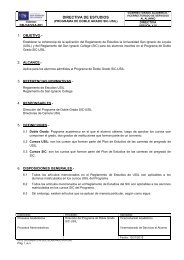Characterization of Starch from two Ecotypes of Andean Achira ...
Characterization of Starch from two Ecotypes of Andean Achira ...
Characterization of Starch from two Ecotypes of Andean Achira ...
You also want an ePaper? Increase the reach of your titles
YUMPU automatically turns print PDFs into web optimized ePapers that Google loves.
Downloaded by TEXAS A&M UNIV COLL STATION on August 13, 2009Published on July 24, 2009 on http://pubs.acs.org | doi: 10.1021/jf9004687F J. Agric. Food Chem., Vol. XXX, No. XX, XXXX Cisneros et al.Texture analyses <strong>of</strong> achira starch gels (8% starch) follow thesame trend as Rapid Visco Amylography (5% starch) androtational viscometry (2% starch) in that San Gaban achiraproduces stronger starch gels than the Sandia achira ecotype. Thecause for this difference in gel strength could lie in the greateramylose content <strong>of</strong> San Gaban achira starch compared to Sandiaachira. Previous studies have found a positive relationshipbetween amylose content and starch gel strength/viscosity forsome botanical species (20).In summary, achira starch showed some unusual properties,such as very large granules and relatively high amylose content.San Gaban achira ecotype formed high-consistency gels uponcooling, as shown in RVA study (5% starch) and in textureanalysis (8% starch), compared to the other starch gels studied.This ecotype also exhibited higher thermal resistance to viscositybreakdown at elevated temperatures (121 °C).ACKNOWLEDGMENTThis work is dedicated to the memory <strong>of</strong> Dr. Ralph Waniska,who kindly collaborated in this study.LITERATURE CITED(1) Thomas, D. J.; Atwell, W. A. <strong>Starch</strong>es; Eagan Press: St. Paul, MN, 1999.(2) Wurzburg, O. B. Modified <strong>Starch</strong>es: Properties and Uses; CRC Press:Boca Raton, FL, 1986; pp 3-40.(3) National Research Council. Lost Crops <strong>of</strong> the Incas: Little-KnownPlants <strong>of</strong> the Andes with Promise for Worldwide Cultivation; NationalAcademy Press: Washington, DC, 1989; pp 27-38.(4) Hermann, M. <strong>Starch</strong> noodles <strong>from</strong> edible canna. In Progress in NewCrops; Janick, J., Ed.; ASHS Press: Arlington, VA, 1996.(5) Perez, E.; Breene, W. M.; Bahnassey, Y. A. Variations in thegelatinization pr<strong>of</strong>iles <strong>of</strong> cassava and arrowroot native starches asmeasured with different thermal and mechanical methods. <strong>Starch</strong>/Staerke 1998, 50, 70–72.(6) Santacruz, S.; Koch, K.; Svensson, E.; Ruales, J.; Eliasson, A. C.Three underutilised sources <strong>of</strong> starch <strong>from</strong> the <strong>Andean</strong> region inEcuador. Part I. Physicochemical characterization. Carbohydr.Polym. 2002, 49, 63–70.(7) Soni, P. L.; Sharma, H.; Srivastava, H. C.; Gharia, M. M. Physicochemicalproperties <strong>of</strong> Canna edulis starch;comparison with maizestarch. <strong>Starch</strong>/Staerke 1990, 42, 460–464.(8) Thitipranphunkul, K.; Uttapap, D.; Piyachomkwan, K.; Takeda, Y.A comparative study <strong>of</strong> edible canna starch <strong>from</strong> different cultivars.Part I. Chemical composition and physicochemical properties.Carbohydr. Polym. 2003, 53, 317–324.(9) Association <strong>of</strong> Official Analytical Chemists (AOAC). Official Methods<strong>of</strong> Analysis, 15th ed.; Washington, DC, 1990.(10) American Association <strong>of</strong> Cereal Chemists. Approved Methods <strong>of</strong> theAACC, 9th ed.; St. Paul, MN, 1995.(11) Takahashi, S.; Maningat, C. C.; Seib, P. A. Acetylated and hydroxypropylatedwheat starch: paste and gel properties compared withmodified maize and tapioca starches. Cereal Chem. 1989, 66, 499–506.(12) Hung, P. V.; Morita, N. Physicochemical properties and enzymaticdigestibility <strong>of</strong> starch <strong>from</strong> edible canna grown in Vietnam. Carbohydr.Polym. 2005, 61, 314–321.(13) Lourdin, D.; Della Valle, G.; Colonna, P. Influence <strong>of</strong> amylosecontent on starch films and foams. Carbohydr. Polym. 1995, 27, 261–270.(14) Rindlav-Westling, A.; Stading, M.; Hermansson, A.-M.;Gatenholm, P. Structure, mechanical and barrier properties <strong>of</strong>amylose and amylopectin films. Carbohydr. Polym. 1998, 217–224.(15) Hoover, R. Composition, molecular structure, and physicochemicalproperties <strong>of</strong> tuber and root starches: a review. Carbohydr. Polym.2001, 45, 253–267.(16) Smith, P. S. <strong>Starch</strong> derivatives and their use in foods. In FoodCarbohydrates; Lineback, D. R., Inglett, G. E., Eds.; AVI Publishing:Westport, CT, 1982.(17) Chen, P.; Yu, L.; Kealy, T.; Chen, L.; Li, L. Phase transition <strong>of</strong>starch granules observed by microscope under shearless and shearconditions. Carbohydr. Polym. 2007, 68, 495–501.(18) Atkin, N. J.; Abeysekera, R. M.; Robards, A. W. The events leadingto the formation <strong>of</strong> ghosts remnants <strong>from</strong> the starch granule surfaceand the contribution <strong>of</strong> the granule surface to the gelatinizationendotherm. Carbohydr. Polym. 1998, 36, 193–204.(19) Li, J. Y.; Yeh, A. I. Relationships between thermal, rheologicalcharacteristics and swelling power for various starches. J. Food Eng.2001, 50, 141–148.(20) Howling, D. The influence <strong>of</strong> the structure <strong>of</strong> starch on its rheologicalproperties. Food Chem. 1980, 6, 51–61.Received February 10, 2009. Revised manuscript received April 29,2009. Accepted July 03, 2009. We are grateful for the financial support<strong>from</strong> CONCYTEC, Peru (Contract 412-2001-OAJ).



